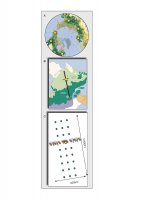Scale of Biodiversity
Dimensions of Biodiversity: An Interdisciplinary Study of Hyperdiverse Endophytic Fungi and their Function in Boreal Forests
Aim 1: Unveil the scale of boreal endophyte biodiversity
For additional information, contact Betsy Arnold (Arnold@ag.arizona.edu)
The last 25 years have witnessed an explosion of studies examining endophyte diversity, primarily with culture-based approaches at small spatial scales. However, inferring the true scale and distribution of that diversity, and the mechanisms that drive it, is difficult because studies differ in sampling intensity, cultivation conditions, and species concepts.
We aim to bridge these gaps by applying both culture-based and culture-free methods to evaluate the biodiversity, spatial heterogeneity, host associations, and environmental sensitivity of endophytes associated with boreal plants and lichens at multiple spatial scales.
Circumboreal survey. We will intensively sample endophyte diversity from 10 species of plants and 10 species of lichens representing boreal communities in six sites spanning three continents along the circumboreal belt. Study sites will be located near the regional center of the boreal biome along a north-south axis in three regions of North America (Québec, Canada; Alberta, Canada; north of Fairbanks, Alaska), Sweden (Vindeln), and two regions of Russia (northwestern and northeastern Russia). At each, we will identify three microsites separated by 10-50m in which 20 focal species co-occur, sampling sufficient material for vouchers (herbarium specimens for the host country and the University of Arizona Herbarium, ARIZ), and culturing (Québec, Alberta, Alaska, Sweden), pyrosequencing following total genomic DNA extraction (all six sites), and cloning for three focal species examined in environmental and community-turnover analyses (Québec). Focal hosts will represent (1) every major phylogenetic lineage of plants or lichens, (2) diverse guilds (e.g., arborescent vs. mat-like plants; fruticose, crustose, and foliose lichens with saxicolous, muscicolous, terricolous, or epiphytic habits and cyanobacterial vs. algal photobionts); and (3) circumboreal genera or species to maximize inferential power regarding host affiliations and geographic effects.
Environmental gradient: north-south transects. The boreal element in Québec occupies a relatively narrow north-south band, providing an opportunity to span the thermal and climatic gradient encompassing the complex threats to southern and northern edges of the boreal biome. Sampling along three ca. 1400 km, parallel transects of nine sites each, each containing three microsites, we will use pyrosequencing to capture endophyte diversity in two phylogenetically distant and ecologically important plant species (Picea mariana, black spruce; Pleurozium schreberi, Schreber’s feathermoss) and one lichen (Peltigera malacea), shown in preliminary surveys to harbor diverse and abundant endophytes.
Community turnover and fire history analysis. To capture the spatial scale of species turnover in endophyte communities we will sample Pi. mariana, Pl. schreberi, and Pe. malacea at nine additional sites arrayed bidirectionally from our central sampling point at exponentially increasing east-west distances along a parallel of latitude in Québec using pyrosequencing and, to validate its quality and provide longer and more phylogenetically informative reads, cloning. Because fires are intrinsic to boreal vegetation dynamics we will sample the same host species in 10 paired sites paralleling the east-west transect, capturing spatial proximity but different fire history as determined by dendrochronological analysis.
We will generate up to 1700 cultures/site (6800 cultures overall), which will be accessioned as living vouchers in a public collection (ARIZ), and deposited at CBS following description of new species. We anticipate ca. 9000 ITS-LSU sequences from clones and >18 million partial ITS reads from pyrosequencing.






